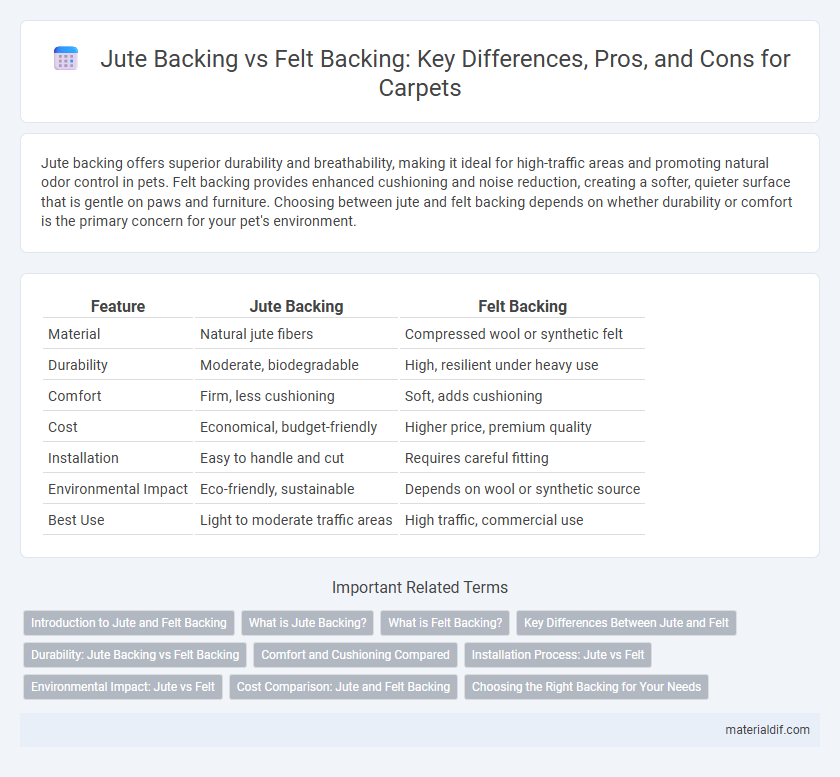Jute backing offers superior durability and breathability, making it ideal for high-traffic areas and promoting natural odor control in pets. Felt backing provides enhanced cushioning and noise reduction, creating a softer, quieter surface that is gentle on paws and furniture. Choosing between jute and felt backing depends on whether durability or comfort is the primary concern for your pet's environment.
Table of Comparison
| Feature | Jute Backing | Felt Backing |
|---|---|---|
| Material | Natural jute fibers | Compressed wool or synthetic felt |
| Durability | Moderate, biodegradable | High, resilient under heavy use |
| Comfort | Firm, less cushioning | Soft, adds cushioning |
| Cost | Economical, budget-friendly | Higher price, premium quality |
| Installation | Easy to handle and cut | Requires careful fitting |
| Environmental Impact | Eco-friendly, sustainable | Depends on wool or synthetic source |
| Best Use | Light to moderate traffic areas | High traffic, commercial use |
Introduction to Jute and Felt Backing
Jute backing, derived from natural plant fibers, offers eco-friendly, breathable support commonly used in carpet manufacturing. Felt backing, made from compressed fibers like wool or synthetic materials, provides dense cushioning and enhanced durability. Both backings influence carpet performance, with jute prioritizing sustainability and felt emphasizing resilience and comfort.
What is Jute Backing?
Jute backing is a natural fiber material derived from the jute plant, widely used as a base layer in carpets and rugs due to its strength and eco-friendly properties. It provides excellent durability and breathability, making it ideal for supporting woven textiles while maintaining sustainability. Compared to synthetic alternatives, jute backing promotes biodegradability and is favored in environmentally conscious flooring solutions.
What is Felt Backing?
Felt backing is a dense, durable layer made from compressed natural or synthetic fibers, used primarily in carpets and rugs to provide cushioning and insulation. Unlike jute backing, felt backing offers superior noise reduction and enhanced comfort underfoot due to its thicker, softer texture. Its moisture-resistant properties make felt backing ideal for high-traffic areas where durability and sound absorption are essential.
Key Differences Between Jute and Felt
Jute backing is a natural, biodegradable material known for its breathability and eco-friendliness, commonly used in rugs and carpets to provide a firm, sturdy foundation. Felt backing, made from compressed synthetic or natural fibers, offers superior cushioning, noise reduction, and insulation properties compared to jute. Key differences include jute's sustainable, moisture-wicking nature versus felt's enhanced durability, softness, and resistance to wear and tear.
Durability: Jute Backing vs Felt Backing
Jute backing provides moderate durability with natural breathability that helps maintain carpet integrity but may degrade faster in high-moisture environments. Felt backing offers enhanced cushioning and superior durability, especially under heavy foot traffic, due to its dense fiber composition. Choosing felt backing ensures longer-lasting carpet support and better resistance to wear compared to jute backing.
Comfort and Cushioning Compared
Jute backing offers firm support and moderate cushioning, making it suitable for natural fiber rugs with a traditional feel. Felt backing provides superior softness and enhanced cushioning, improving comfort underfoot and reducing noise. The denser structure of felt backing also delivers better insulation compared to the rougher texture of jute.
Installation Process: Jute vs Felt
Jute backing offers a lightweight, flexible material that simplifies carpet installation due to its natural texture, allowing easy cutting and positioning, while felt backing provides a denser, thicker layer that can require more effort to lay flat and secure. Jute's breathability promotes quicker acclimatization during installation, reducing the risk of mold or mildew underneath, whereas felt backing's moisture retention properties may extend drying times. Installers often prefer jute for projects needing a quicker setup and eco-friendly option, while felt is chosen for its added cushioning and soundproofing despite a more involved installation process.
Environmental Impact: Jute vs Felt
Jute backing is a sustainable, biodegradable material derived from natural plant fibers, significantly reducing environmental impact compared to felt backing, which often contains synthetic fibers and chemicals. The production of jute involves fewer carbon emissions and less water usage, making it an eco-friendly choice for carpet and rug backing. In contrast, felt backing typically requires intensive manufacturing processes that contribute to pollution and are less recyclable, leading to greater environmental harm.
Cost Comparison: Jute and Felt Backing
Jute backing is generally more affordable than felt backing, making it a popular choice for cost-conscious consumers and large-scale projects. Felt backing tends to be more expensive due to its additional processing, providing enhanced cushioning and durability. The price difference can significantly impact the overall budget, especially in extensive carpet installations or industrial applications.
Choosing the Right Backing for Your Needs
Jute backing offers natural breathability and durability, making it ideal for eco-conscious consumers seeking sustainable carpet support with excellent resilience. Felt backing provides enhanced cushioning and sound insulation, suitable for areas requiring extra comfort and noise reduction. Choosing the right backing depends on usage demands, with jute favored for longevity and environmental benefits, while felt is preferred for softness and acoustic performance.
Jute Backing vs Felt Backing Infographic

 materialdif.com
materialdif.com